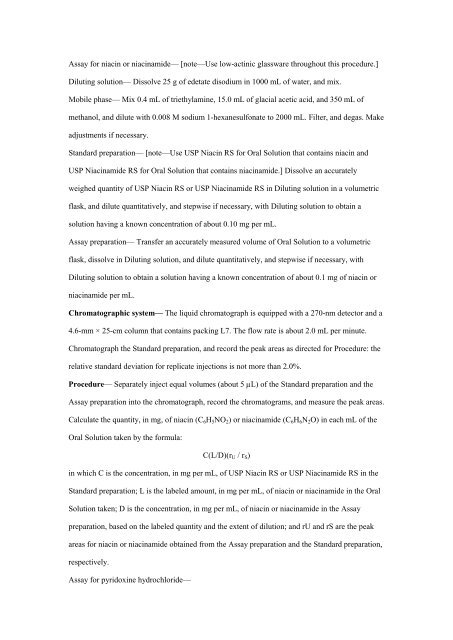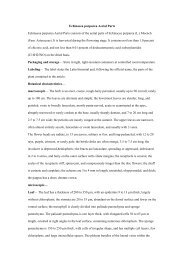Oil- and Water-Soluble Vitamins with Minerals Oral Solution Oil- and ...
Oil- and Water-Soluble Vitamins with Minerals Oral Solution Oil- and ...
Oil- and Water-Soluble Vitamins with Minerals Oral Solution Oil- and ...
You also want an ePaper? Increase the reach of your titles
YUMPU automatically turns print PDFs into web optimized ePapers that Google loves.
Assay for niacin or niacinamide— [note—Use low-actinic glassware throughout this procedure.]<br />
Diluting solution— Dissolve 25 g of edetate disodium in 1000 mL of water, <strong>and</strong> mix.<br />
Mobile phase— Mix 0.4 mL of triethylamine, 15.0 mL of glacial acetic acid, <strong>and</strong> 350 mL of<br />
methanol, <strong>and</strong> dilute <strong>with</strong> 0.008 M sodium 1-hexanesulfonate to 2000 mL. Filter, <strong>and</strong> degas. Make<br />
adjustments if necessary.<br />
St<strong>and</strong>ard preparation— [note—Use USP Niacin RS for <strong>Oral</strong> <strong>Solution</strong> that contains niacin <strong>and</strong><br />
USP Niacinamide RS for <strong>Oral</strong> <strong>Solution</strong> that contains niacinamide.] Dissolve an accurately<br />
weighed quantity of USP Niacin RS or USP Niacinamide RS in Diluting solution in a volumetric<br />
flask, <strong>and</strong> dilute quantitatively, <strong>and</strong> stepwise if necessary, <strong>with</strong> Diluting solution to obtain a<br />
solution having a known concentration of about 0.10 mg per mL.<br />
Assay preparation— Transfer an accurately measured volume of <strong>Oral</strong> <strong>Solution</strong> to a volumetric<br />
flask, dissolve in Diluting solution, <strong>and</strong> dilute quantitatively, <strong>and</strong> stepwise if necessary, <strong>with</strong><br />
Diluting solution to obtain a solution having a known concentration of about 0.1 mg of niacin or<br />
niacinamide per mL.<br />
Chromatographic system— The liquid chromatograph is equipped <strong>with</strong> a 270-nm detector <strong>and</strong> a<br />
4.6-mm × 25-cm column that contains packing L7. The flow rate is about 2.0 mL per minute.<br />
Chromatograph the St<strong>and</strong>ard preparation, <strong>and</strong> record the peak areas as directed for Procedure: the<br />
relative st<strong>and</strong>ard deviation for replicate injections is not more than 2.0%.<br />
Procedure— Separately inject equal volumes (about 5 µL) of the St<strong>and</strong>ard preparation <strong>and</strong> the<br />
Assay preparation into the chromatograph, record the chromatograms, <strong>and</strong> measure the peak areas.<br />
Calculate the quantity, in mg, of niacin (C 6 H 5 NO 2 ) or niacinamide (C 6 H 6 N 2 O) in each mL of the<br />
<strong>Oral</strong> <strong>Solution</strong> taken by the formula:<br />
C(L/D)(r U / r S )<br />
in which C is the concentration, in mg per mL, of USP Niacin RS or USP Niacinamide RS in the<br />
St<strong>and</strong>ard preparation; L is the labeled amount, in mg per mL, of niacin or niacinamide in the <strong>Oral</strong><br />
<strong>Solution</strong> taken; D is the concentration, in mg per mL, of niacin or niacinamide in the Assay<br />
preparation, based on the labeled quantity <strong>and</strong> the extent of dilution; <strong>and</strong> rU <strong>and</strong> rS are the peak<br />
areas for niacin or niacinamide obtained from the Assay preparation <strong>and</strong> the St<strong>and</strong>ard preparation,<br />
respectively.<br />
Assay for pyridoxine hydrochloride—




